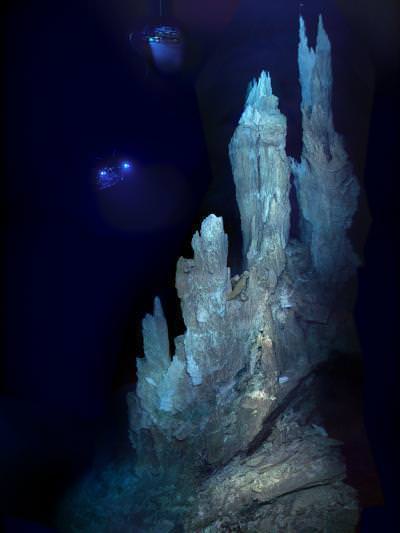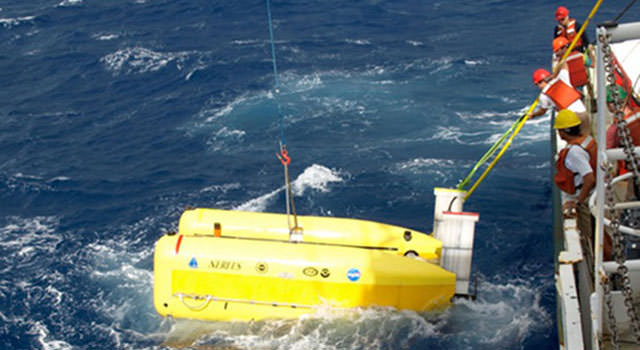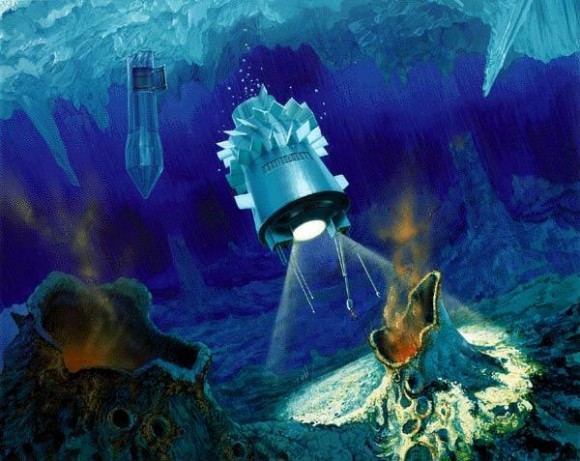[/caption]
White sand, blue water, sunny skies, pina coladas. When you think of “extreme environments” I doubt the Caribbean is high on your list. But a team of scientists from Woods Hole Oceanographic institute and NASA’s Jet Propulsion Laboratory, exploring the 68-mile-long Mid-Cayman rise deep beneath the surface of the Caribbean, have discovered the deepest known hydrothermal vent in the world, along with two other distinct types of vents.
The mid-Cayman rise is a much smaller version of the mid-ocean ridge system, a chain of submarine mountains that encircles the globe. These ridges form in locations where tectonic plates are pulling apart, allowing mantle rocks to melt and emerge at the surface as lava. Seawater, percolating through the hot rocks at these spreading centers, is superheated and emerges at vents, bearing a rich bounty of dissolved nutrients to support thriving ecosystems that can live without any sunlight.
“This was probably the highest-risk expedition I have ever undertaken,” said chief scientist Chris German, a Woods Hole Oceanographic Institution geochemist who has pioneered the use of autonomous underwater vehicles to search for hydrothermal vent sites. “We know hydrothermal vents appear along ridges approximately every 100 kilometers [62 miles]. But this ridge crest is only 100 kilometers long, so we should only have expected to find evidence for one site at most. So finding evidence for three sites was quite unexpected – but then finding out that our data indicated that each site represents a different style of venting – one of every kind known, all in pretty much the same place – was extraordinarily cool.”




Maybe we can check out Europa this way. The catch is getting such a submersible under the thick ice crust.
LC
It will be an important test bed no doubt, if all three types of vents is within a few km and further it is a much needed check on low-temperature vents.
Now I’m not as optimistic about vents as “food chain” communities as mentioned here. Our own vent species have a long history through a photosynthetic driven biosphere, none of the extant species were derived directly from this environment as far as anyone knows. Who knows if and how a vent-originated cell community would develop?
Our own true multicellulars originated from a very special branch of cells (eukaryotes), which are unlikely to repeat elsewhere. This further lowers the likelihood of expecting “food chain” communities.
But the upshot is that this environment applies generally. For example, something like it could very well be applicable to Enceladus, who for some reason looks more and more like Europa (possibly differentiated core, possibly once hot core, possibly remaining hot spots/hot core).
The jury is still out on that one, I believe. But maybe we only need to lower a probe/submersible “rover” down cracks in some cases.
“Europa Analog Deep-Sea Vents”
Oh, come on. I really do like you guys and have be a fan of this website for a few years but man. WE HAVE NEVER DISCOVERED ANY SUCH VENT ON EUROPA. In fact, while the Jupiter Galileo Mission’s magnetic data provided evidence that Europa has a liquid-saltwater layer under the visible surface, we still have no true proof.
These vents were discovered on Earth and exist only on as far as we know at this time and HOW do you get off calling them analogs to vents on Europa….
Do you understand that the word “science” means “to know”? Do you not remember the lesson that Mariner 2 taught us , about jumping to conclusions before the evidence is in? At least keep these speculations in the text of the article, not the headline.
Vanamonde, first I reacted so too.
But it really makes sense; the salty ocean shows that there is a connection to the mineral core, and as it is still active, ergo vents is a substantiated prediction. And these are a plethora of vent types, likely all we can expect. So it is a reasonable prediction.
It is the whole process. A better pity summary would be “get to know”.
And testable theories like Europa vents are one of the better ways to eventually get to knowledge; in fact one can argue successfully that knowing the possible testable theories in an area _is_ already knowledge: it starts to constrain possibilities.
“Speculations”, but useful speculations.
Now you lost me. It is the usefulness of these analogs that were interesting in the first place.
Well said Vannamonde. I agree that is too much of this jumping to conclussions and assuming what ‘works’ here on earth is therefore going to ‘work’ elsewhere/everywhere. While certain basic physics and chemistry appear to be universal systems such as hydrothermal vents will only work on planets with an active plate system [and deep ocean of course]. Quite whether Enceladus and Europa have a dynamic enough crust/mantle is open to debate and some doubt. Certainly Io is an active body but that’s due to flexing brought about by the gravity of Jupiter but that’s a different process.